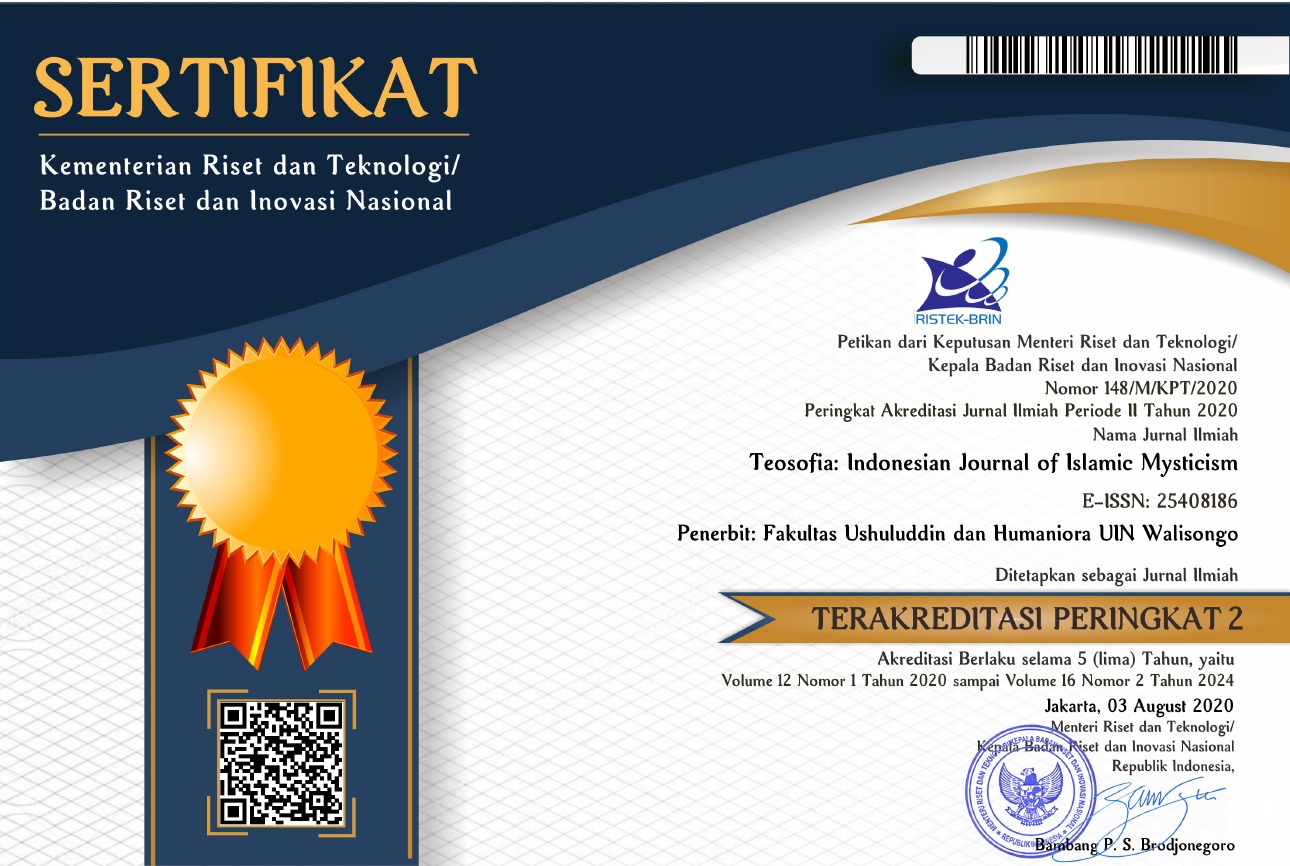THE SPIRITUAL MEANING OF SULUK IN SYI’IR TANPA WATON
DOI:
https://doi.org/10.21580/tos.v7i2.4405Keywords:
K. H. Mohammad Nizam As-shofa, Syi’ir Tanpa Waton, suluk kecil (khalwat fi al-khalwat), suluk besar (khalwat fi al-jalwat), Syi'ir Tanpa Waton, Suluk, Spiritual MeaningAbstract
Syi’ir Tanpa Waton, a work of KH Mohammad Nizam As-shofa, is a sufi poem. It is a
cultural endeavor to response the modern problems of Muslims who easily judge others
infidels without realizing their own infidelity. This poem is used as a closing recitation of
Reboan Agung (Islamic regular study forum of Muslim conducted in every Wednesday night learning the book of Jamī’ al-uṣul fi al-uliyā’ the work of Shaykh Ahmad Dhiya 'uddin Musthofa Al-Kamisykhonawi) and the book of Al-Fatḥurrabbani wa al-Faiḍurrahmani the work of Shaykh Abdul Qadir al-Jilani. The forum took place at Islamic boarding school of Ahlus-Shofa Wal Wafa Sidoarjo, East Java. This research is inspired by spiritual emptiness caused by the modernization and the shallow understanding of Islamic teachings. Islam is studied and practiced at the level of shari'a without deepening it into higher stages of Sufism i.e. tariqa, haqiqa and even marifa. This study employs content analysis and qualitative approach aims at analyzing the message or moral values contained in the literature. Then, I classifies basic thoughts into some themes and selects these themes to find the central idea of the text. Substantively, the verses were structurely written ranging from understanding comprehensively the teachings of Islam, teachings self-awareness, the teachings of social piety (humanism) and the teachings of Sufism namely suluk practice. Suluk in Syi’ir Tanpa Waton is devided into two parts, namely: small suluk (khalwat fi al-khalwat) and big suluk
(khalwat fi al-jalwat). Meanwhile, suluk nafs/soul purification and suluk Qalb/heart
purification are called takhalli/purgativa. In addition to that, sirr emptying (tahalli/contemplative) followed by soul enlightening (Tajalli/Illuminativa) is a chain of
process or stages that should be passed in the form of small and big suluk which take place in suluk Qalb (takhalli/purgativa) and sirr emptying (tahalli/contemplative). Suluk in the present context is urgently needed for peaceful soul to face negative effects of
modernization and spiritual crisis of modern human by doing seclusion physically and
mentally (qalb/jasad) from the crowd of human life. Seclusion is a symbol of taqarrub ilallāh by self-equipping with spiritual values to depend on nothing but Allah. This process will consruct oneself to be calm, patient, active, productive, firmly independent, consistent, having integrity and good personality
Downloads
References
Siroj, Said Aqil. 2006. Tasawuf Sebagai Kritik Sosial, Bandung:Mizan.
Akbar, Muhammad Ali. Studi Tentang Suluk Dalam Tarekat Naqsyabandiyah Khalidiyah Aminiyah.
Ali, Yunasril. 1992. Membersihkan Tashawwuf Dari Syirik, Bid'ah Dan Khurafat, Jakarta: Pedoman Ilmu Jaya.
Berger, Peter L. 1991. Langit Suci Agama Sebagai Realitas Sosial terj. Hartono. Jakarta: LP3ES.
Braginsky, 1998. Yang Indah Berfaidah dan Kamal; Sejarah Sastra Melayu dalam Abad 7-9, Jakarta: INIS.
Bruinessen, Mratin Van. 1992. Tarekat Naqsabandiyah di Indonesia Survei Historis, Geografis Dan Sosiologis. Bandung: Mizan.
Jumantoro, Totok dan Samsul Munir Amin, 2005. Kamus Ilmu Tasawuf. Jakarta: Amzah.
Muhyiddin, Ahmad Shofi, 2015. Syiir Tanpa Waton Al-Maghfurlah K. H. Abdurrahman Wahid (Gus Dur), Yogyakarta: Ladang Kata.
Munawir, Ahmad Warsun. 1997 Kamus Al-Munawir Arab-Indonesia Terlengkap, Yogyakarta: Pustaka Progressif.
Muthahhari, Murtadha dan S. M. H. Thabathaba’i, 1997. Menapak Jalan Spiritual, Terj, Bandung: Pustaka Hidayah.
Nasr, Sayyid Husein. 1993. Spiritualitas dan Seni Islam, terj. Sutejo, Bandung: Mizan.
Nur, Edy Yusuf. 2014. Mengali Tasawuf yang hakiki,Yogyakarta:Suka Press.
Nur, Sayyid bin Sayyid Ali. 2000. Tasawuf Syar’i, Jakarta: Hikmah.
Panitia PIBSI XXIII UAD, 2002. Bahasa dan Sastra Indonesia Menuju Transformasi Sosial Budaya Abad XXI, Yogyakarta: Gama Media.
Putra, Erfandi. 2015. Syi’ir Tanpa Waton dan Sejarahnya, Sidoarjo: As-Shofa.
Roziq, Fahrur. 2016. Pondok Pesantren Ahlus-Shofa Wal Wafa Pengkaderan Dunia Akherat, Sidoarjo: As-Shofa.
Salamah, Ummu. 2005. Sosialisme Tarekat Menjejaki Tradisi dan Amaliyah Spiritual Sufisme, Bandung: Humaniora.
Sugeng Sugiono, 1993. Bunga Rampai Bahasa Sastra dan Kebudayaan Islam, Yogyakarta: Fakultas Adab IAIN Sunan Kalijaga.
Syukur, M. Amin. 20012. Menggugat Tasawuf Sufisme dan Tanggung Jawab Sosial Abad 21, Yogyakarta: Pustaka Pelajar.
Tim Penyusun Kamus Pusat Pembinaan dan Pengembangan Bahasa. 1989. Kamus Besar Bahasa Indonesia. Jakarta: Balai Pustaka.
Zahri, Mustafa. 1973. Kunci Memahami Ilmu Tasawuf, Surabaya: Bina Ilmu.
Sumber dari Wawancara:
Wawancara dengan Mohammad Nizam Ash Shofa pengasuh ponpes Ahlus Shofa-wal wafa, di Sidoarjo tanggal 18 Mei 2016.
Wawancara dengan Abdul Wahab Machfudz, Khalifah (Wakil Guz Nizam) di Ponpes Ahlus-Shofa Wal Wafa Sidoarjo tanggal 18 Mei 2016.
Sumber dari Internet:
https://www.youtube.com/watch?v=Hu-fp6gKUZM Di unduh pada 10 April 2016.
https://www.youtube.com/watch?v=eDdCnF6c4WA Di unduh pada 10 April 2016.
Downloads
Published
How to Cite
Issue
Section
License
Copyright
The copyright of the received article shall be assigned to the journal as the publisher of the journal. The intended copyright includes the right to publish the article in various forms (including reprints). The journal maintains the publishing rights to the published articles. Therefore, the author must submit a statement of the Copyright Transfer Agreement.*)
Licensing

This work is licensed under a Creative Commons Attribution-ShareAlike 4.0 International License.
In line with the license, authors are allowed to share and adapt the material. In addition, the material must be given appropriate credit, provided with a link to the license, and indicated if changes were made. If authors remix, transform or build upon the material, authors must distribute their contributions under the same license as the original.
_______
*) Authors whose articles are accepted for publication will receive confirmation via email and send a Copyright Transfer Agreement.









